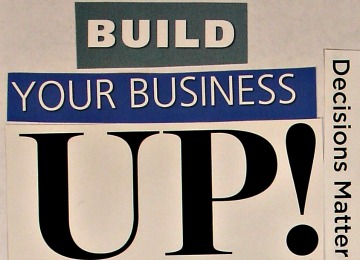Home Page | Blog | Managing | Marketing | Planning | Strategy | Sales | Service | Networking | Voice Marketing Inc.
Strategy in Business: The Importance of the Strategic Management Process
Effective Corporate Strategic Planning
Strategy in Business: for the best impact use a strategic management process that is customized to your business. Corporate strategic planning is particularly important during a recession cycle and/or during challenging economic times.
Search This Site

Your strategy in business needs to be part of your ongoing improvement strategy; particularly during a recession cycle.
What is a recession? Will a focus on strategic optimization help your business?
Can strategic planning software help you produce an effective plan that gets you the results you want?
Changing your strategy in business is necessary when the economy around you changes; use a flexible strategic management process and, if possible, use strategic planning software to build and test 'what if' scenarios.
When we enter, exist in, and finally exit a recession cycle we need to focus on strategic optimization to adapt to the new, and quickly-changing, environments.
History shows us that some businesses will do well, even in challenging economic conditions.

As a small business owner, you need to do some things differently to capitalize on the marketing and sales upside of a slow economy (yes, there can be an upside if you can respond quickly and adapt your strategy).
Focus your efforts on marketing and planning as a key element in adapting your strategic small business plan; and make sure that you are actively and consistently scanning your marketplace to be able to quickly adapt to changes in the economic environment.
Building an effective strategy in business needs to be your number one priority!
Strategy and a Recessionary Environment:
First, it is important to understand and consider, what is a recession?
Most economists consider a country is in recession when its gross domestic product is negative for two successive quarters of the year (or more).
Another recession definition is business or economic activity contraction. The global economy entered a period of recession late in 2008. By the end of 2009, some countries around the world were beginning to see signs of improvement; and announcing the end of the recession.
Over the past five years, a number of countries world-wide have cycled in, out and back in to recession; therefore it is important to understand how to operate in a recession both locally and globally.
A global recession impacts all businesses as customers stop spending money and industries contract across all markets.
Corporate strategic planning is usually what 'big' business invests in; yet as a small business owner you don't have large staff departments to help you run business models or 'what if' scenarios. So consider alternatives.
You can access strategic planning software to look at some specific scenarios (such as new product development and launches; geographic expansion; diversification strategies; changing pricing scenarios; competitive actions and reactions; and more).
Or you can break down the planning process into smaller, more managable, segments that you can work on over time.
Changing Your Strategy in Business:
How to Survive a Recession Cycle:
Review your vision statement. Is it still relevant for you? Remember that your vision statement is a long term view of your business future; don't change it in reaction to what is expected to be a short term (less than two years) issue.
Refocus your priorities, your goals and your action plan. For example, this might be the time to expand into markets that you have been considering. Look into mergers, acquisitions, or opening new branches or stores. You might be able to acquire a failing company for much less money than in good times. To do this you must have funds on hand and available; this is not the time to add more debt and/or to constrain your cash flow. Another example is to consider rationalizing and redefining your product line. Do you have money losers: are they loss leaders or do they not contribute anything to your business?
Review your business strategy, and change if necessary. Are you a market follower, market leader, market challenger? Is it time to change your strategy and focus on less risk (following) and, typically, make do with less volume? Or do you want to focus on growing even during difficult times; and you have managed to reduce your operations costs and therefore are able to reduce your price?
Re-do your strengths, weaknesses, opportunities and threats (SWOT) analysis as part of your marketing plan. Consider the impact of a slow or recessionary economy on that analysis. If you are vulnerable to dollar exchange rates, do you need to hedge against significant swings? How strong are your suppliers; is there any risk that they may go under? Do you have a back up plan? How strong are your customers; is there any risk that one or more customers of significant size will go out of business? Are you tracking any increasing issues on receivables? How will you handle this? One suggestion I have is to look for smaller accounts: 10 customers who do $10,000 worth of business with you annually is the same volume as 1 customer doing $100,000 worth of business with you but your risk is spread amongst 10 customers rather than centered on one. (It is important to recognize that there is more cost in working with 10 customers compared to one but in this economic environment it might be worth the increased cost.)
Review your business performance measurements. Do you need to add other measurements to your daily/weekly/monthly/quarterly review? For example, liquidity ratios, gross profit margin for all accounts, number of estimates or proposals (are they declining, increasing, are you winning more or less), and more.
Redevelop your marketing communication plan to focus on recession marketing. Redefine your brand and how you are perceived by your customers and other stakeholders. Change your communication, product and pricing strategies.
Increase the effectiveness of your employees. Employee training development, sales negotiation training, and sales development training are just a few examples of additional training you need to provide your employees to increase their effectiveness and your sales.
Change your customer service approach; even if you provide good customer service now look to provide exceptional customer service and to build stronger customer loyalty. Understand your customers' concerns and continue to add value to your product or service. One way of signaling your commitment to change is to develop surveys to measure customer satisfaction, research new product development, and more. This is the time, more than ever before, to continuously improve your strategy in business - to talk to your customers and to actively listen to what they have to say.
Redefine how you connect with customers. Use services such as social media (YouTube, Twitter, LinkedIn, etc.) to connect and prove that you understand their needs and expectations. Acknowledge to your customers that times are going to be tough; build stronger community relations and be seen to be a community member.
Strategic Optimization:
Be Flexible and Adapt Your Plan
Your market may have down-sized due to economic forces such as a recession cycle but your share of the market can stay the same or grow if you manage your business approach effectively, adapt your strategic management process, and focus your business efforts on strategic optimization.
Businesses that survive, and even succeed, during recessionary times will understand the need to increase their spending on advertising and marketing. Grow your share of voice and market during these challenging times. Competitors will often stop spending on advertising and marketing. Their share of voice and market will shrink.
By reviewing the recession definition above in the context of adapting your strategy in business to grow your business during a global recession, you will be able to focus on positive changes that will allow your business to succeed during challenging, and changinge, conditions.
More-For-Small-Business Newsletter:
For more timely and regular monthly information on managing your
small business,
please subscribe here.
Read More about Strategy in Business and
how the Business or Corporate Strategic Planning Process
Can Help Your Organization Succeed:
Return to Strategy as it relates to your business.
Or Return from Strategy in Business to More For Small Business.
Use a Value Chain Analysis to focus your business on a successful strategy.
Subscribe to
More Business Resources E-zine
The Importance of Strategy
Why is strategizing important to your business?
Because it enables you to more clearly understand what you need to do to more your operation in the direction you need, and want, to go.
Doing a thorough analysis and review will enable you to implement more effective strategies, tactics and techniques.
Results and Strategy

Definition of Business Model: It's Different
The type of tactical planning you complete as you strategize is important because it forces you to make difficult choices and difficult decisions.
(Make sure you understand the definition business model - the practices, and focus, of the business on delivering the value proposition - to engage in a strong and successful strategic planning process).
Also write down your choices and decisions to plan the actions necessary to move forward (use samples to provide you with a model for your own action plan).
The action plan is your road map. You must ensure that you are managing the direction you take.
Once you begin this planning process you will need to ensure that the plan you develop is do-able; make sure you include effectiveness measures in your plan.
And remember that your plan for strategy in business needs to be reviewed on a regular basis and be adapted as market and economic conditions change.
The end goal is not the plan but rather the results therefore make sure you have measurements in place to track results.
This Site
Tools for Strategy Planning
Start with your SWOT (strengths, weaknesses, opportunities and threats) analysis.
Add aspirations and results to the SWOT (some do SOAR (strengths, opportunities, aspirations, and results) as a separate activity) to ensure that your vision for your business is incorporated in your goals and objectives.
Conduct a market opportunity analysis and look for unmet needs that align with your objectives.
Doing a thorough analysis and review will enable you to implement more effective strategies, tactics and techniques.







